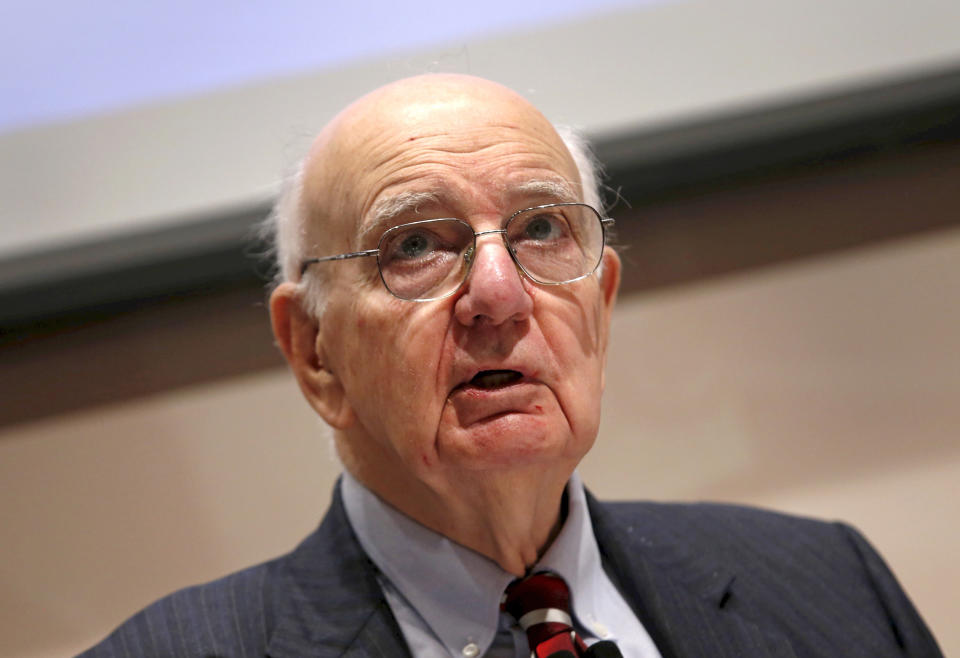Former Fed Chairman Paul Volcker dies at 92
Paul Volcker, the former Federal Reserve Chairman who tackled the Great Inflation by inspiring a rethink of monetary policy, died on Sunday at the age of 92, The New York Times reports, citing confirmation from his daughter, Janice Zima.
During his eight years at the helm of the central bank, Volcker endured a number of economic crises: rampant inflation, an unstable dollar, the Latin American sovereign debt crisis, and the collapse of Continental Illinois National Bank. Through it all, Volcker made quick use of the Fed’s toolbox, elevating the Fed to its modern-day reputation as the first responder to economic crises.
Volcker’s successors at the Fed remember him as a dedicated public servant.
Fed Chairman Jerome Powell said in a statement that Volcker’s “contributions to the nation left a lasting legacy.” Powell’s predecessor, Janet Yellen, said she was inspired by Volcker’s “courage to do the right thing, even when it’s immensely unpopular.”
Having spent most of his career within the Federal Reserve System or at the U.S. Treasury, Volcker remained active in public service even after leaving the Fed in 1987. In the aftermath of the 2008 financial crisis, Volcker controversially pushed for regulatory scrutiny of risky trading at the nation’s banks. The “Volcker rule” limitation on proprietary trading was a centerpiece of the post-crisis Dodd-Frank financial regulatory framework.

In recent years, Volcker publicly lamented the state of current affairs, worrying that a deterioration in decorum in Washington, D.C. has eroded respect of the government and the central bank. For his part, Volcker wrote in his 2018 memoir “Keeping At It” that he felt comfortable with how he left the Fed.
“I could leave office with a sense of satisfaction that the Federal Reserve was a well-respected institution, capable of providing leadership in a never-ending effort to achieve and maintain financial stability,” Volcker wrote.
‘I need more’
Volcker was perhaps most known for his battle with inflation. Rising prices was an obsession since college.
In 1945, Volcker picked a fight with his mom over the $25-a-month allowance that he was going to receive once he started college at Princeton. Pointing out that his older sisters got the same amount of money when they went to college, Volcker argued that the weakened purchasing power of the dollar put him at a disadvantage.
“‘We’ve had inflation, mother, I need more,’” Volcker recalled in an interview with a Fed historian. “She said, ‘I don’t care.’”
As it happened, inflation was the primary problem when Volcker ascended to Fed chairman in 1979. He immediately inherited an economy where prices were inflating to the tune of nearly 10%.

Volcker was eager to undo the passive monetary policies of his predecessor Arthur Burns, who was reluctant to counteract a devaluating dollar still reeling from the 1971 decision to end the dollar’s convertibility to gold, known as the “Nixon shock.”
Between 1975 and 1979, Volcker served as the president of the New York Fed, earning him a seat at the monetary policy-setting table. Volcker took issue with Burns’s “loose” monetary policy.
“When the Bretton Woods system was breaking down, Burns would be sitting there, saying, ‘I don’t want to do anything to the dollar,’” Volcker recounted in a 2008 interview. “I thought, ‘Well, go home and raise interest rates, do something to defend the dollar.’”
When Volcker took over an economy that, by extension, was suffering from rampant inflation, he moved quick to do exactly that. Within two months of becoming chairman, Volcker abruptly announced that the Fed would be shifting its focus from the level of the benchmark interest rate to the level of bank reserves in the system, referred to as the money supply.

As a result, the federal funds rate ratcheted up quickly, from the already-high level of nearly 14% to almost 18% in April of 1980. Volcker had implemented an economic “shock” of its own, and the dramatically tight policy had begun pushing inflation back down that year.
The Milton Friedman-brand of monetarist theory helped guide the Fed until the early ‘90s, when changes in investment habits weakened the link between money supply changes and economic growth. In 1993, Alan Greenspan reverted to interest rate policies, believing it to be a better transmission device for tightening or loosening economic activity.
After the Fed
Volcker did not retire from the Fed quietly.
During the midst of the financial crisis, Volcker returned to government in a new role, serving as a chairperson of President Barack Obama’s Economic Recovery Advisory Board. In that role, Volcker pushed hard for a rule prohibiting banks from engaging in proprietary trading, believing that risky trades for short-term profits were at fault for the 2008 collapse.
The rule sparked a vicious battle on Capitol Hill, where opponents slammed it as government intervention in free markets. Volcker pushed ahead.
“Critics ask, ‘why are we wasting time on this?’ My answer to that: ‘if you don’t watch out, it’ll be the heart of the next crisis,’” Volcker has said.
Although the rule was ultimately passed into law as a part of the Dodd-Frank regulatory framework, regulators are still working on implementing it over 10 years out from the financial crisis.
In a cynical yet prophetic manner, Volcker recalled in 2010 that regulators would “never do it,” referring to regulators’ sluggish approach to new rules.
The episode reflected Volcker’s passion for public service, even beyond his time as Fed chair, as well as his pragmatic approach to public policy.
Volcker is survived by his two children from his first marriage and his wife, Anke Dening.
Brian Cheung is a reporter covering the banking industry and the intersection of finance and policy for Yahoo Finance. You can follow him on Twitter @bcheungz.

 Yahoo Finance
Yahoo Finance 
